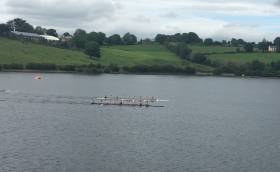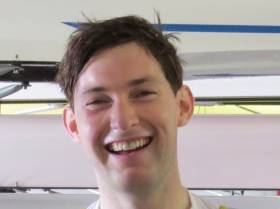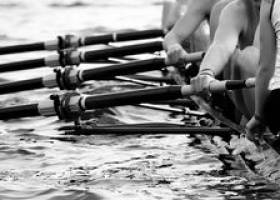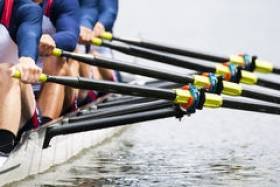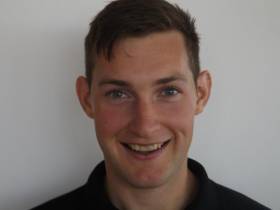Displaying items by tag: Cork Regatta
Cork Regatta Postponed Due to Forecast of Bad Weather
#Rowing: Cork Regatta has been called off for this weekend. The two-day Grand League event has been re-fixed for next weekend (June 29th and 30th). The forecast for this weekend was for high winds and heavy rain on Sunday, with conditions deteriorating on Saturday afternoon and evening. Declarations will be on Wednesday evening, but while crews can withdraw, no new entries will be accepted.
#Rowing: Two strong senior composite crews took home the Division One quadruple titles as the action concluded late into the evening on the first day of Cork Regatta at the National Rowing Centre. The women’s final saw Margaret Cremen join Skibbereen’s Lydia Heaphy, Denise Walsh and Aoife Casey to good effect, and the men’s winners were the prospective Ireland Under-23 lightweight quad. Workmen’s and Shandon junior 18 crews were good runners up in the women’s and men’s races.
Cork Boat Club won the Division One men’s coxed four title, while Trinity took the women’s.
Cork Regatta, National Rowing Centre (Selected Results)
Men
Eight – Div Two: Neptune (club two) 6:22.95; 4 Trinity (nov) 6:34.32; 5 Col Iognaid (jun 16) 6:35.63; 6 Shandon (jun 18B) 6:43.79.
Four – Div One, coxed: Cork (inter) 6:34.299; 3 Enniskillen A (jun 18A) 6:39.299. C Final: 2 Neptune (club one) 6:48.37.
Pair – Div One: 1 UCD (S Mulvaney, D O’Malley; sen) 6:53.31, 2 Skibbereen (M O’Donovan, S O’Driscoll; sen) 6:59.98, 3 Enniskillen (jun 18A) 7:06.75; 6 Cork A (inter) 7:23.68. B Final: 6 Neptune A (club one) 7:24.50.
Sculling, Quadruple – Div One: 1 Tara, UCD, Commercial, UCC (sen) 6:00.93, 2 Shandon (jun 18) 6:10.96
Double – Div Two: CRCC (jun 18B) 7:06.99; 5 Cork A (jun 16) 7:15.37. B Final: Cappoquin (club two) 7:20.43
Single Sculls: 1 Skibbereen (P O’Donovan; sen) 6:59.73. B Final: UCC (H Sutton; lwt) 7:20.63. C Final: 1 Shandon (E Gaffney; jun 18A) 7:28.92; 2 Queen’s (N Hull; inter) 7:29.86
Women
Eight- Div Two: Trinity A (club two) 6:52.696; 6 Commercial (jun 16) 7:15.45. B Final: 1 Queen’s (nov) 7:19.09.
Four, coxed – Div One: 1 Trinity (inter) 7:25.63, 2 Commercial (sen) 7:30.06; 5 Shandon (club one) 7:46.78.
Pair – Div One: 1 Skibbereen (A McCarthy, N Casey; sen) 7:49.73; 4 Col Iognaid (Jun 18A) 8:07.86; Shandon (club one) 8:08.78. C Final: 4 Shandon (inter) 8:36.00.
Sculling, Quadruple – Div One: 1 Skibbereen/Lee 6:50.49; 2 Workmen’s (jun 18A) 7:05.596. Div Two: 1 Cork A (club two) 7:50.05; 3 Carlow (jun 16) 8:03.97. B Final: Carlow (jun 18B) 8:13.43; 4 Queen’s (nov) 8:25.47.
Double – Div Two: 1 Killorglin (jun 18B) 7:41.63, 2 New Ross (club two) 7:56.41, 3 Carlow (jun 16) 8:00.41
Heats No Problem for O'Donovan Brothers at Cork Regatta
#Rowing: Paul O’Donovan won his heat of the single sculls in an excellent time of seven minutes 7.8 seconds in glorious sunshine at Cork Regatta today. The Skibbereen man had 2.7 seconds to spare over heavyweight oarsman Ronan Byrne of UCC. Gary O’Donovan wont the previous heat in the third-fastest time, with Sam McKeown not far behind, setting the fourth fastest time overall.
Lisa Dilleen of Cork Boat Club was the fastest women’s single sculler in the heats, with Denise Walsh of Skibbereen second.
UCC/Skibbereen Women's Eight Win on the Line at Cork Regatta
#Rowing: The Skibbereen/UCC composite won the women’s eights with the final few strokes at the Cork Grand League Regatta today. NUIG led them coming up to the line, but the winners finished faster to win by three tenths of a second. Cork were the best junior 18 eight.
UCD won the men’s eights by holding off NUIG. The finish was close, but UCD had led down the course and refused to yield. Neptune took the junior 18 honours by holding off St Joseph’s of Galway in the B Final.
Cork Regatta, National Rowing Centre, Cork, Day Two (Selected Results)
Men
Eight – Division One – A Final: 1 UCD (N Farrell, R Thompson, E O’Connor, C O’Riada, E Gleeson, A Griffin, T Doherty, M Murphy; cox: O Reid; senior) 5:51.05, 2 NUIG (sen) 5:51.91, 3 UCD (inter) 6:05.098; 4 Cork (club one) 6:05.46. B Final: 4 Neptune (Jun 18A) 6:13.69.
Four – Div One – A Final: 1 NUIG (sen) 6:16.41. Four, coxed – Div Two – A Final: 1 Queen’s B (club two) 6:53.69, 2 St Michael’s (jun 18B) 6:56.53; 6 Presentation, Cork (jun 16) 7:33.61.
Sculling,
Quadruple, Div Two, coxed – A Final: 1 Carlow (jun 18B) 6:43.70; 3 Castleconnell (jun 16) 6:53.53; 4 Shandon (club two) 6:54.67.
Double – A Final: 1 Skibbereen (G O’Donovan, P O’Donovan; sen) 6:25.51, 2 Commercial, UCD (N Beggan, A Goff; sen) 6:27.62, 3 Skibbereen (M O’Donovan, S O’Driscoll; sen) 6:37.997; 5 Three Castles A (jun 18A) 6:49.76. B Final: St Michael’s (inter) 6:51.20.
Single – Div Two – A Final: 1 Three Castles (A Keogh; jun 16) 7:29.64, 2 Cappoquin (S Landers; club two) 7:35.39; 6 Killorglin (J McCarthy; Jun 18B) 7:52.86.
Women
Eight – Div One – A Final: 1 Skibbereen/UCC (O Hayes, F O’Keeffe, A Casey, E McCarthy A Keogh, E Hegarty, N Casey, D Walsh; cox C O’Connell; senior) 6:37.94, 2 NUIG (sen) 6:38.30; 5 NUIG (club one) 6:58.38. B Final: 1 Cork (jun 18A) 7:00.93; 2 Shandon (inter) 7:02.79.
Four – Div One – A Final: 1 Skibbereen, UCC (N Casey, E Hegarty, A Keogh, D Walsh; sen) 6:59.0. B Final: Col Iognaid (jun 18A) 7:39.68. Div Two, coxed – A Final: Trinity (club two) 7:41.79.
Sculling, Double – Div One – A Final: 1 Cork (inter) 7:19.591, 2 Lee (jun 18A) 7:23.45. B Final: 2 Carlow (club one) 7:40.31. Div Two – A Final: 1 Neptune (J Poh; club two) 8:40.47, 2 Kenmare (E Crowley; jun 18B) 8:42.76; 3 Neptune (N Clarke; jun 16) 8:46.62.
Commercial and UCD Double Test O'Donovans at Cork Regatta
#Rowing: Niall Beggan and Andrew Goff gave Gary and Paul O’Donovan a good battle in the Division One double sculls at Cork Regatta today. The Ireland under-23 lightweights, drawn from UCD and Commercial, placed second behind the Ireland senior lightweight double, ahead of Shane O’Driscoll and Mark O’Donovan.
NUIG won the men’s fours and the Skibbereen/UCC composite the women’s four by convincing margins. Cork won the women’s double, while Lee’s juniors took second.
Cork Regatta, National Rowing Centre, Cork, Day Two (Selected Results)
Men
Four – Div One – A Final: 1 NUIG (sen) 6:16.41. Four, coxed – Div Two – A Final: 1 Queen’s B (club two) 6:53.69, 2 St Michael’s (jun 18B) 6:56.53; 6 Presentation, Cork (jun 16) 7:33.61.
Sculling, Double – A Final: 1 Skibbereen (G O’Donovan, P O’Donovan; sen) 6:25.51, 2 Commercial, UCD (N Beggan, A Goff; sen) 6:27.62, 3 Skibbereen (M O’Donovan, S O’Driscoll; sen) 6:37.997; 5 Three Castles A (jun 18A) 6:49.76. B Final: St Michael’s (inter) 6:51.20.
Single – Div Two – A Final: 1 Three Castles (A Keogh; jun 16) 7:29.64, 2 Cappoquin (S Landers; club two) 7:35.39; 6 Killorglin (J McCarthy; Jun 18B) 7:52.86.
Women
Four – Div One – A Final: 1 Skibbereen, UCC (N Casey, E Hegarty, A Keogh, D Walsh; sen) 6:59.0. B Final: Col Iognaid (jun 18A) 7:39.68.
Sculling, Double – Div One – A Final: 1 Cork (inter) 7:19.591, 2 Lee (jun 18A) 7:23.45. B Final: 2 Carlow (club one) 7:40.31.
#Rowing: Paul O’Donovan set a new personal best as a single sculler at Cork Regatta today. The Skibbereen sculler won the Division One A Final in six minutes 50.819 seconds. Gary O’Donovan was 13 seconds further back in sunny conditions with a cross-tailwind.
Sanita Puspure pulled out of the women’s single sculls final, but she had already won the heat, beating Monika Dukarska by six seconds. Dukarska won the final.
Mark O’Donovan and Shane O’Driscoll beat Shane Mulvaney and David O’Malley by 3.4 seconds after a good race in the men’s pair.
Cork Regatta, National Rowing Centre, Day One (Selected Results)
Men
Eight – Div Two – A Final: 1 UCD B (club two) 6:22.449, 2 Shandon (jun 16) 6:36.97; 4 Trinity (nov) 6:41.7.
Four – Div One, coxed – A Final: 1 NUIG (inter) 6:22.49; 4 UCD B (sen) 6:28.46; 6 Neptune (jun 18A) 6:38.53.
Pair – Div Two – A Final: 1 Skibbereen (sen) 6:36.43; B Final: 2 Cork (jun 18A) 7:03.17. C Final: 5 Neptune A (club one) 7:16.46.
Sculling,
Quadruple – Div One – A Final: 1 UCC, UCD, Skibbereen (sen) 5:57.88; 2 Three Castles (jun 18A) 6:11.99. B Final: UCC (club one) 6:38.49.
Double – Div Two – A Final: 1 Shandon (jun 18B) 6:57.74; 3 Waterford (club two) 7:04.61; 4 Castleconnell A (jun 16) 7:11.77.
Single – A Final: 1 Skibbereen (P O’Donovan; sen) 6:50.82. B Final: 3 Shandon (D Begley; inter) 7:19.11; 4 Castelconnell (J Quinlan; jun 18A)
Women
Eight – Div Two – A Final: 1 Skibbereen (club two) 6:54.5; 5 Trinity (nov) 7:21.92; 6 St Michael’s (jun 16) 7:26.8.
Four, coxed – Div One – A Final: 1 Cork (sen) 7:22.85, 2 NUIG (club one) 7:27.0; 4 Shannon (inter) 7:36.13.
Pair – Div One – A Final: UCC/UCD (sen) 7:35.97; 5 Trinity B (inter) 7:53.23. B Final: Lee (jun 18A) 8:00.457. C Final: Belfast BC (club one) 8:08.607.
Sculling, Quadruple Div One - A Final: Lee (Jun 18A) 6:50.22
Div Two – A Final: 1 Shandon (club two) 7:28.86, 2 Castleconnell (jun 16) 7:31.09; 5 Shandon (jun 18B) 7:54.69.
Double – Div Two – A Final: 1 Carlow (jun 16) 7:44.19; 5 Graiguenamanagh (jun 18B) 8:17.88; 6 Killorglin (club two) 8:23.69.
Single – Div One – A Final: 1 Killorglin (M Dukarska; sen) 7:40.23; 3 Skibbereen (A Casey; jun 18A) 7:56.17; 4 Skibbereen (O Hayes; lwt) 7:59.73. C Final: 2 Skibbereen (L Heaphy; inter) 8:11.60; 6 Garda (J Ryan; club one) 8:44.57.
NUIG Senior Crew Best Eight at Cork Regatta
#Rowing: NUIG's senior eight led in the intermediate crews from UCD and UCC in the division one men's final at Cork Regatta today. Cork took fourth - the fastest junior eight. The UCC/Skibbereen composite crew were far and away the best women's eight at the National Rowing Centre. Behind them, Commercial won their battle with Galway Rowing Club to take second and prove the best of the junior 18 eights.
Cork Regatta (Coillte Grand League), National Rowing Centre, Sunday
Men
Eight - Division One - A Final: 1 NUIG (sen) 5 mins 52.609, 2 UCD (inter) 5:56.374; 4 Cork (jun 18) 6:03.13; 5 Commercial (club 1) 6:04.72.
Four - Div One - A Final: 1 NUIG (senior) 6:15.798. Div Two, coxed - A Final: 1 Cork (club 2) 6:45.96; 4 Presentation (jun 18) 7:01.82. B Final: 5 Pres (jun 16) 7:45.27.
Sculling - Quadruple - Div Two, coxed - A Final: 1 Lee (club 2) 6:38.53; 4 Shandon A (jun 16) 6:50.31; 5 Workmans (jun 18) 6:58.04. C Final: 2 New Ross (nov) 7:16.61.
Double - Div One - A Final: 1 Skibbereen (M O'Donovan, S O'Driscoll; sen) 6:35.19, 2 Shandon/Clonmel 6:42.47; 6 Shandon A (inter) 7:07.91. B Final: 2 Shandon (jun 18) 6:51.83. C Final: 5 Cork (club 1) 7:51.21.
Single - Div Two - A Final: 1 Skibbereen (K Mannix; jun 18) 7:30.79, 2 Carlow (J Keating; jun 16) 7:32.62; 4 Lee (H Sutton; club 2) 7:38.78.
Women
Eight - Div One - A Final: 1 Skibbereen/UCC (sen) 6:38.217, 2 Commercial (club 1) 6:56.12, 3 Cork (jun 18) 7:01.12.
Four - Div One - A Final: 1 UCC (sen) 7:08.25; 3 Shandon (jun 18) 7:17.69. Div Two, coxed - A Final: 1 Fermoy (club 2) 7:25:19.
Sculling, Double - Div One - A Final: 1 Skibbereen (E Hegarty, A Casey; jun 18) 7:13.15, 2 Bann (jun 18) 7:22.69; 5 Belfast BC (club 1) 7:34.93. B Final: 2 Commercial (inter) 7:47.37; 3 Skibbereen (sen) 7:47.68.
Single - Div Two - A Final: 1 Kenmare (G O'Brien; jun 18) 8:25.59; 3 Skibbereen (A Keating; jun 16) 8:27.898; 6 Queen's (R Brown; club 2) 6:49.93.
Junior Doubles Impress at Cork Regatta
#Rowing: NUIG and UCC won the division one men's and women's fours by big margins in the first set of Sunday finals at Cork Regatta at the National Rowing Centre. The division one doubles provided a stage for junior crews with international aspirations. In changeable conditions, Aoife Casey and Emily Hegarty won in an excellent time and Ronan Byrne and Daire Lynch were second to senior internationals Shane O'Driscoll and Mark O'Donovan.
Cork Regatta (Coillte Grand League), National Rowing Centre, Sunday
Men
Four - Div One - A Final: 1 NUIG (senior) 6:15.798. Div Two, coxed - A Final: 1 Cork (club 2) 6:45.96; 4 Presentation (jun 18) 7:01.82. B Final: 5 Pres (jun 16) 7:45.27.
Sculling - Double - Div One - A Final: 1 Skibbereen (M O'Donovan, S O'Driscoll; sen) 6:35.19, 2 Shandon/Clonmel 6:42.47; 6 Shandon A (inter) 7:07.91. B Final: 2 Shandon (jun 18) 6:51.83. C Final: 5 Cork (club 1) 7:51.21.
Single - Div Two - A Final: 1 Skibbereen (K Mannix; jun 18) 7:30.79, 2 Carlow (J Keating; jun 16) 7:32.62; 4 Lee (H Sutton; club 2) 7:38.78.
Women
Four - Div One - A Final: 1 UCC (sen) 7:08.25; 3 Shandon (jun 18) 7:17.69.
Sculling, Double - Div One - A Final: 1 Skibbereen (E Hegarty, A Casey; jun 18) 7:13.15, 2 Bann (jun 18) 7:22.69; 5 Belfast BC (club 1) 7:34.93. B Final: 2 Commercial (inter) 7:47.37; 3 Skibbereen (sen) 7:47.68.
Lightweight Quadruple Again Shows its Class
#Rowing: Young, ambitious, crews impressed in the second set of finals at Cork Regatta at the National Rowing Centre. The Ireland under-23 lightweight quadruple were outstanding in their win - setting a time of six minutes 4.37 seconds - and the prospective women's Coupe de la Jeunesse quadruple also had plenty to spare in their victory.
UCD's men and Commercial's women won the division one coxed fours. Skibbereen, with a mix of experienced and younger oarswomen, won the division two eight.
Cork Regatta (Coillte Grand League), National Rowing Centre, Day One
Men
Eight - Div Two - A Final: 1 UCD (Club 2) 6:10.51; 3 Neptune (jun 18B) 6:26.949; 5 UCD (nov) 6:35.449; 6 Shandon (jun 16) 6:36.01.
Four, coxed - Div One - A Final: 1 UCD (inter) 6:35.94; 3 UCC (sen) 6:43.51; 4 Cork (jun 18) 6:43.94. B Final: 1 Commercial (club 1) 6:49.11.
Pair - Div One - A Final: 1 Skibbereen (M O'Donovan, S O'Driscoll; sen) 6:47.31, 2 Portora (inter) 7:00.21, 3 Portora (sen) 7:03.97. B Final: 4 Methodists (jun 18A) 7:27.72. C Final: 5 Cork (Club 1) 7:39.03.
Sculling, Quadruple - Div One - A Final: 1 UCC, Tara, UCD, Skibbereen (sen) 6:04.368; 3 Portora (inter) 6:21.93; 4 Lee (jun 18) 6:23.62. B Final: 4 Lee (Club 1) 6:44.75.
Double - Div Two - A Final: 1 Queen's A (club 2) 7:09.19, 2 Workmans B (jun 18) 7:17.83, 3 Neptune A (jun 16) 7:21.53.
Single - Div One - A Final: 1 UCD (P O'Donovan; sen) 6:55.78, 2 Skibbereen (G O'Donovan; sen) 7:03.98, 3 Portadown (S McKeown; sen) 7:20.81; 4 Shandon (R Byrne; jun 18) 7:21.20; 5 St Michael's (D O'Connor; inter) 7:21.58. B Final: 6 NUIG (T Dillon; lwt) 7:39.37. C Final: 2 Carlow (L Keating; Club One) 7:30.86.
Women
Eight - Div Two - A Final: 1 Skibbereen (club 2) 6:58.49; 3 Shandon (jun 18) 7:11.02; 6 Col Iognaid (jun 16) 7:19.29. B Final: 4 Neptune (nov) 8:22.96. Four, coxed - Div One - A Final: 1 Commercial (sen) 7:27.80, 2 St Michael's (inter) 7:35.00, 3 Fermoy (club 1) 7:36.35.
Pair - Division One - A Final: 1 Cork A (jun) 7:49.19, 2 UCC (sen) 7:53.55, 3 Bann (inter) 7:59.863. B Final: Queen's/UCC (sen) 8:01.37. C Final: St Michael's 8:21.57.
Sculling, Quadruple - Div One - A Final: 1 Belfast, Bann, Lee, Skibbereen (sen) 6:53.96; 3 Carlow (jun18) 7:29.68. Div Two, coxed - A Final: 1 New Ross (jun 16) 7:40.26, 2 Cork B (Club 2) 7:41.14; 5 Carlow (jun 18B) 7:48.997. C Final: 3 Castleconnell (nov) 8:24.174.
Double - Div Two - A Final: 1 Clonmel (jun 18) 7:53.74; 3 Workmans (jun 16) 8:06.90; 4 Lee Valley (club 2) 8:10.26.
Single - Div One - A Final: 1 Skibbereen (D Walsh; sen) 7:51.57, 2 Tribesmen (S McCrohan; sen) 8:04.30, 3 Skibbereen (O Hayes; sen) 8:09.94; 4 Belfast BC (O Blundell; inter) 8:21.16. B Final: Belfast BC (C Deyermond; club 1) 8:25.96; 2 Neptune (C Feerick; jun 18A) 8:28.71. C Final: Carlow (A Byrne; lwt) 9:05.89.
Paul O'Donovan Wins Battle of the Brothers
#Rowing: Paul O'Donovan was far and away the fastest single sculler at Cork Regatta at the National Rowing Centre today. The 22-year-old UCD man had a clearwater lead by halfway and beat his younger brother, Gary into second by over eight seconds. The O'Donovans form the Ireland Olympic lightweight double. Paul will go on to represent his country as a lightweight single sculler at the World Championships.
Denise Walsh was a convincing winner of the women's senior single, well ahead of Siobhan McCrohan, while the very promising Cork Boat Club junior crew of Amy Mason and Tara O'Hanlon won the Division One women's pair. Shane O'Driscoll and Mark O'Donovan took the men's senior pair, ahead of the Portora intermediate crew of Ryan Ballantyne and Barney Rix.
The New Ross junior 16 crew had a stirring victory in the women's division two coxed quad, while UCD's club two crew won the men's division two eight.
Cork Regatta (Coillte Grand League), National Rowing Centre, Day One
Men
Eight - Div Two - A Final: 1 UCD (Club 2) 6:10.51; 3 Neptune (jun 18B) 6:26.949; 5 UCD (nov) 6:35.449; 6 Shandon (jun 16) 6:36.01.
Pair - Div One - A Final: 1 Skibbereen (M O'Donovan, S O'Driscoll; sen) 6:47.31, 2 Portora (inter) 7:00.21, 3 Portora (sen) 7:03.97. B Final: UCC 7:09.969; 4 Methodists (jun 18A) 7:27.72. C Final: 1 Commercial B (sen) 7:19.64; 5 Cork (Club 1) 7:39.03.
Sculling, Single - Div One - A Final: 1 UCD (P O'Donovan; sen) 6:55.78, 2 Skibbereen (G O'Donovan; sen) 7:03.98, 3 Portadown (S McKeown; sen) 7:20.81; 4 Shandon (R Byrne; jun 18) 7:21.20; 5 St Michael's (D O'Connor; inter) 7:21.58. B Final: Clonmel (D Lynch; jun 18) 7:20.48; 6 NUIG (T Dillon; lwt) 7:39.37. C Final: Shandon (D Begley; inter) 7:29.43; 2 Carlow (L Keating; Club One) 7:30.86.
Women
Pair - Division One - A Final: 1 Cork A (jun) 7:49.19, 2 UCC (sen) 7:53.55, 3 Bann (inter) 7:59.863. B Final: Queen's/UCC (sen) 8:01.37. C Final: St Michael's (inter) 8:21.57.
Sculling, Quadruple - Div Two, coxed - A Final: 1 New Ross (jun 16) 7:40.26, 2 Cork B (Club 2) 7:41.14; 5 Carlow (jun 18B) 7:48.997. B Final: Waterford (jun 18B) 7:54.796. C Final: Commercial (club 2) 8:18.91; 3 Castleconnell (nov) 8:24.174.
Single - Div One - A Final: 1 Skibbereen (D Walsh; sen) 7:51.57, 2 Tribesmen (S McCrohan; sen) 8:04.30, 3 Skibbereen (O Hayes; sen) 8:09.94; 4 Belfast BC (O Blundell; inter) 8:21.16. B Final: Belfast BC (C Deyermond; club 1) 8:25.96; 2 Neptune (C Feerick; jun 18A) 8:28.71. C Final: Carlow (A Byrne; lwt) 9:05.89.


























